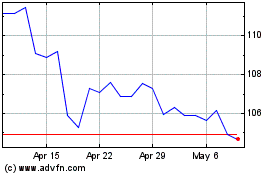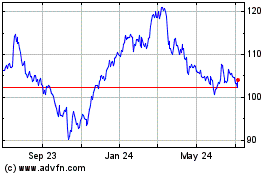At a medical meeting last winter, a drug-industry executive
flipped his nametag around so he could have more open conversations
with the liver-disease scientists who were presenting their
research.
"They didn't recognize who I am. No one does," recalled John
Milligan, who a few months later was named chief executive of
Gilead Sciences Inc.
Dr. Milligan may find it increasingly difficult to stay so
anonymous as he settles into the pilot seat at Gilead, a company
that has catapulted into one of the industry's biggest sellers and
most controversial drug pricers.
Since the company started launching costly new hepatitis C
treatments in 2013, Gilead sales have risen nearly 3½ times to
$32.2 billion last year, and shares have jumped more than 130%
since then. The company's Sovaldi and Harvoni commanded the biggest
drug launches ever, as 920,000 patients world-wide lined up for the
promise of a cure.
Yet Gilead has more recently been forced to heavily discount the
hepatitis C pills to cope with mounting competition, and faces
questions about the market's long-term prospects as more patients
get cured.
Scrutiny over the drugs' $1,000-a-day list price lingers,
despite the discounting. Gilead has faced heavy criticism and a
Senate probe. Massachusetts is also investigating whether the high
prices violate state laws on unfair trade practices.
Meantime, the company's HIV/AIDS franchise is aging.
Given such pressures, some on Wall Street question the company's
ability to keep up its heady pace of growth. Gilead shares trade at
less than eight times consensus earnings, a lower multiple than any
peer, according to Geoffrey Porges, a Leerink Partners analyst.
"The stock is trading as if it is facing an existential threat
that will result in a 30% to 40% erosion of its earnings," says Dr.
Porges, who recommends buying the stock. Many investors would feel
much better, he says, if Gilead added a new franchise to its
lineup.
Dr. Milligan, a trained biochemist who is a 26-year veteran of
Gilead, is tasked with finding that next source of growth and
shoring up faith that the company can continue delivering
blockbusters.
Investors have been looking for a new deal with the same kind of
impact as the $11 billion acquisition of Pharmasset Inc. in 2012,
which netted Gilead its lucrative hepatitis C franchise. But
industry officials such say such transactions are hard to find,
especially with biotech valuations relatively high.
He also must address the company's negative public image around
pricing, no easy task for a longtime insider.
"The lesson is we have to do a lot better job talking about the
value we provide," Dr. Milligan says.
Dr. Milligan, who brings home science journals to read and
watches TED talks in his spare time, says he intends to stay on top
of the science of drug discovery because it is so crucial in
identifying new growth opportunities. Gilead is investing nearly $3
billion on R&D. And he will keep attending medical meetings,
such as the liver-disease conference last November, and peppering
researchers with questions.
Dr. Milligan says he isn't counting on another deal of the scale
of the Pharmasset transaction. "My preference is to stay with the
smaller series of acquisitions for the company, rather than trying
to solve it all at once. But I reserve the right to change my
mind."
Among the diseases that Gilead is targeting through a
combination of in-house research and deal-making are a liver
condition called nonalcoholic steatohepatitis, or NASH, and
immune-system disorders like rheumatoid arthritis. Gilead is also
in cancer.
"Rather than having one opportunity, I would like to have
multiple opportunities for the future," Dr. Milligan says. The idea
isn't to find the single next "big thing, like Pharmasset, but work
three different angles that would all be growth" drivers.
Dr. Milligan says he wants Gilead to remain a lean, focused
drugmaker, and avoid the pitfalls of bigness, such as large
committee meetings that go on far too long and interminable email
chains. Spaces still aren't assigned in the parking garage at
Gilead's Foster City, Calif., headquarters, and Dr. Milligan says
he regularly eats lunch in the corporate cafeteria so he can chat
directly with staff. Dr. Milligan wants to keep the company's
employee count, now about 8,000, relatively low.
"I'm a little maniacal about preserving the culture," he
says.
He says he was inspired by two figures: his father, David
Milligan, who was a chief scientific officer at Abbott
Laboratories, as well as his father's boss George Rathmann, who
went on to run pioneering biotech Amgen Inc.
Dr. Rathmann, he says, showed how a biotech executive can stay
on top of scientific developments and let them drive
decision-making. "If I'm close to the science, it means everyone
else will stay close to the science as well," Dr. Milligan
says.
Write to Jonathan D. Rockoff at Jonathan.Rockoff@wsj.com
(END) Dow Jones Newswires
June 06, 2016 12:05 ET (16:05 GMT)
Copyright (c) 2016 Dow Jones & Company, Inc.
Abbott Laboratories (NYSE:ABT)
Historical Stock Chart
From Mar 2024 to Apr 2024

Abbott Laboratories (NYSE:ABT)
Historical Stock Chart
From Apr 2023 to Apr 2024
